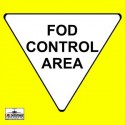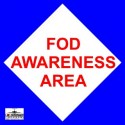There is a way to find out, and not only is it
called F.A.S.T. – but it is that, too!by MSgt Steve Ball, Minot Air Force Base
(F.A.S.T.) Overview
Here’s the low down on the Failure Analysis Service Technology. This process is an investigation technique carried out by Mr. George Morse of FAST at his offices in Pine Mountain, California, using an electron-scanning microscope to determine the identity of foreign materials left behind on damaged areas during a FOD event. It is as potentially as important to your FOD/Flight program as the FOD*BOSS because it is the only way I know of to determine with a high degree of certainty what an engine ingested, especially when the damage isn’t apparent. With FAST available there is no reason to simply report “Unknown” regarding source or cause of damage. If you are ever going to prevent a FOD mishap from re-occurring, the initial cause must be known so the appropriate preventative measures may be implemented.
A brief synopsis of the FAST process:
Purchase a Failure Analysis Services Technology (F.A.S.T.) kit. Inside the kit are a wooden dowel, small bottle of acetone, non-adhesive tape, several size pairs of tweezers, two dozen glass Gelman dishes and a syringe.
Also included are pre-paid FEDEX envelopes for shipping, and bubble-wrapped inner envelopes. It amounts to a lifetime supply because when you get low on anything Mr. Morse will send free replacements in about three working days. The cost of the kit also purchases Mr. Morse’s consultation fees, overhead, a $3000/year dangerous goods shipment course taught by FEDEX that Morse’s company must be re-certified on annually, $85 dangerous goods shipment charge for the acetone per kit, and the cost of fabricating each kit.
When FOD damage occurs to an aircraft, take FAST samples following instructions provided in the kit, (as many samples as deemed necessary), including control samples of adjacent surfaces. Include photos and suspected samples of rivets, concrete, or any other material that may have caused the damage.
If you must ship out the engine to a depot for repairs, send in the samples and photos before the engine departs. This will prevent possible contamination in between your origin and the depot. You will receive a report in 3-5 working days. The more data/samples provided, the better the report will be.
If you took FAST samples, and then the engine or airframe is repaired on-site and you don’t need to send anything in at that time, simply store the samples a while longer just in case the report is eventually needed. If not, discard later.
At this writing the cost is $1465 to have the samples analyzed. The minimum samples you send would be two: One as a control and the other the “damage” sample. The maximum you can send is basically unlimited. Morse will still charge $1465.
The FAST process is being used by a majority of major US airlines, General Electric, FEDEX and all branches of the US military. Mr. Morse is also expert in determining damage sources from photos and blades sent to him, as well as through the use of other investigational techniques.
A side note: Even if an engine is shipped from here with suspected FOD damage and we didn’t take FAST samples, or if there appears to be external FOD damage to an engine but you couldn’t reach the damaged area for analysis, we intend to contact OC/ALC and ask them to sample the damage for us. If they don’t have a kit we’ll send them materials (excluding the acetone). We should be able to work out the details with F.A.S.T. to have the samples analyzed if the 5 BW pays for it.
If you have any questions about the FAST process contact George Morse directly using this email address: george@fod.com
Steve Ball
5 BW FOD Manager
Minot AFB, ND
Want To Know Where Your FOD Came From?
June 15, 2002 by



